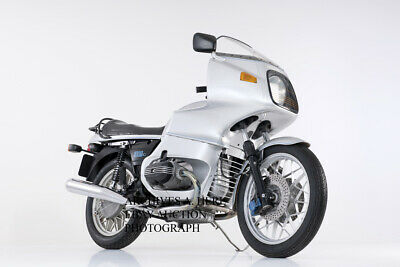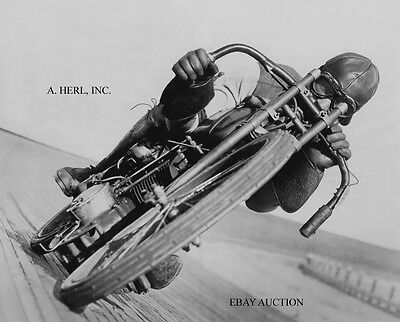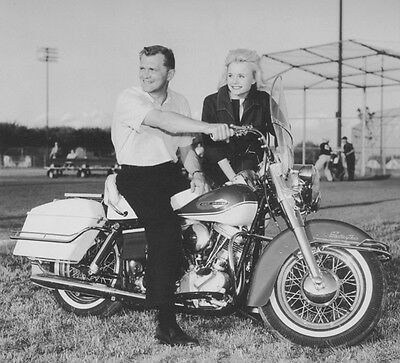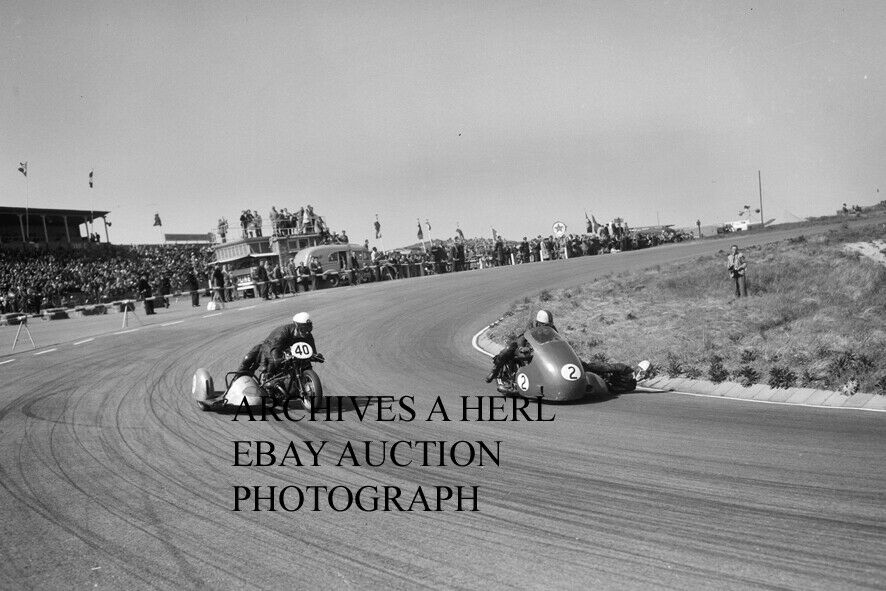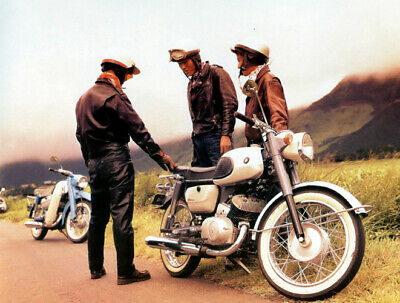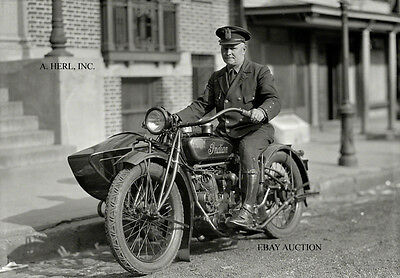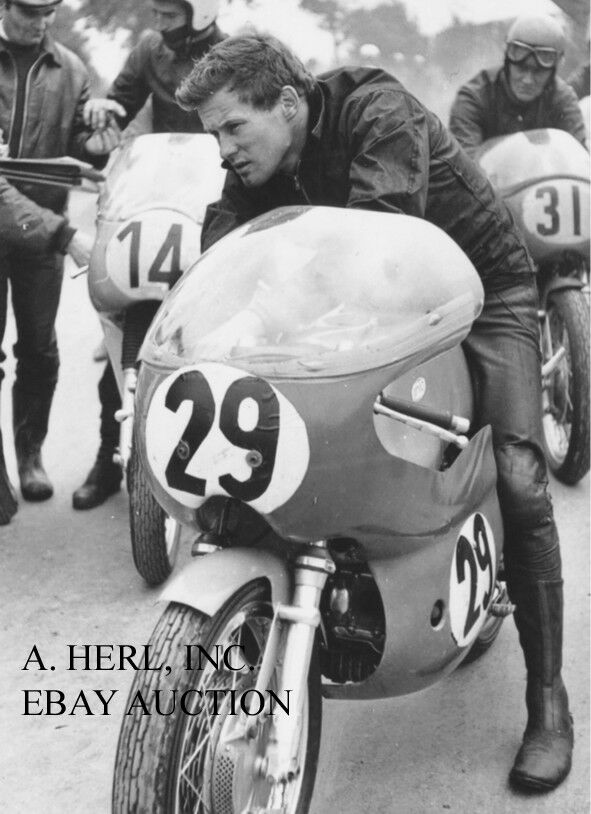-40%
Velocette KTT 350 & BMW 500 worksracers – 1939 Swedish GP Saxtorp - photo
$ 5.14
- Description
- Size Guide
Description
This photograph was taken onthe
10TH of August, 1939
, during the
Swedish Grand Prix
which was held at the
Saxtorp
circuit. Shown are the
Velocette works machines
, with nr. 43 we see the
Velocette KTT
of the
WINNER
of the 350cc race:
Ernie Thomas
. He is visible in the background, behind the nr. 10 and 46 KTT’s.
The Velocette KTT with nr. 10 was ridden by
Austrian Franz Binder
, nr. 46 was ridden by
David Whitworth
.
The
500cc BMW works machines
were ridden by
Wiggerl Kraus
(nr. 5) and
Georg Meier
(nr. 1).
It is a great photo that shows a wonderful era of roadracing!!
Velocette
is the name given to motorcycles that were made by Veloce Ltd, in Hall Green,
Birmingham
,
England
. One of several motorcycle manufacturers in
Birmingham
, Velocette was a small, family-owned firm, selling far fewer hand-built motorcycles than the giant BSA, Norton or Triumph concerns. Renowned for the quality of its products, the company was 'always in the picture' in international motorcycle racing, from the mid-1920s through the 1950s, culminating in two world championship titles (1949–1950 350 cc) and its legendary and still-unbeaten 24 hours at
100 mph
(
161 km/h
) record. Veloce, while small, was a great technical innovator and many of its patented designs are commonplace on motorcycles today, including the positive-stop foot shift and swinging arm rear suspension with hydraulic dampers. The company was founded by John Goodman (born Johannes Gütgemann and later known as John Taylor before formally changing his name to Goodman) and William Gue, as "Taylor, Gue Ltd." in 1905. Its first motorcycle was the Veloce. Later that year, John Taylor set up Veloce Limited, to produce cycles and related products and services. Veloce Ltd initially produced four-stroke motorcycles. The first two-stroke, built in 1913, was called a Velocette. This name was used for all subsequent models. He was joined in 1916 by his sons Percy and Eugene Goodman. Between 1913 and 1925, Veloce only produced expensive, high-quality two-stroke motorcycles of (nominally) 250 cc, which gained an excellent reputation, and which were entered in competitions, such as the Isle of Man TT, with some success. The single-cylinder machines had many advanced features, such as a throttle-controlled oil pump, which set them apart from other manufacturers' products. The factory gradually developed this machine from the 'A' series and variants (A, AC2 - coil ignition, two-speed gearbox, AC3 - three speed gearbox, etc.), then the 'H' series, the model U and variants, culminating in the model GTP in 1930, which was produced until 1946. The GTP was a reliable lightweight motorcycle with good steering and power delivery. In the early 1920s, Veloce realized that in order to grow as a company, it needed a new machine of advanced specification and developed an overhead camshaft (OHC) 350 cc engine, which became known as the 'K' series, introduced in 1925. After a year of teething troubles with this new design, Veloce entered the model KTT into racing events such as the Isle of Man TT and Brooklands races, and the reliability and sweet running qualities of their new engine led to a long string of racing successes. The roadster models developed from this initial model K were the Velocette KSS (super sports), KTS (touring sports), KTP (twin exhaust ports), KN (normal), and a few variations. The OHC engine series continued for roadsters until 1948, when the final KSS versions were produced, with rigid frames and Dowty air-sprung telescopic forks. Accurate valve timing was accomplished through the pioneering use of stroboscopic lamps (see timing light). The 'K' series showed an excellent turn of speed and reliability and soon the factory developed racing models to compete in the Isle of Man TT. In 1933, the company decided to introduce a new line of overhead valve (OHV) machines, in order to cut production costs and make a more affordable motorcycle. The K series was expensive to produce, requiring selective hand assembly of the shaft-and-bevel camshaft drive; it was determined that a simpler OHV design would be quicker to build and require less skilled labour to assemble. The first of these new machines was the MOV, using a 250 cc engine of 'square' dimensions (
68 mm
bore x
68 mm
stroke). It was an immediate sales success, having lively performance for the time (
78 mph
), and proved a reliable machine with excellent road manners. From this machine, by lengthening the stroke of the crankshaft, the Velocette MAC 350 cc was introduced in 1934. It proved even more popular than the MOV, and became a real money spinner for the company, bringing much needed capital into the firm. In 1935 an entirely new machine was introduced, based on the two previous OHV models, the Velocette MSS of 500 cc. A new, heavier frame was utilized with the intention that the machine could serve as a sidecar hauler. This new frame was developed from the mkV KTT racing machine, and was shared with the KSS MKII of 1936-48. The MSS also proved very popular and profitable for Veloce. After the Second World War, the company sought to capture what it saw as a developing need for personal transport and created (with the help of Phil Irving of Vincent fame) the model LE. This was a 192 cc watercooled flat twin with side-valves, a pressed steel frame and telescopic forks and swingarm. It was sophisticated and expensive. Unfortunately it proved less successful than the firm had anticipated and although it became Veloce's best selling model ever, the massive tooling costs for this all-new machine were barely recouped. It did see widespread adoption by British police forces for urban patrol. At the time Metropolitan Police Officers on foot patrol were required to salute Sergeants and Inspectors. With the introduction of the Velocette LE, this became dangerous, requiring the officer to take his hand off the handle bars, and so the rider was to allowed to show his respect with a smart inclination of his head, or to put it another way, to give a smart nod and the bikes became known as 'Noddy Bikes'. At the 1947 TT, the company won the first four places in the Junior race, and in 1950 they were the 350cc World Champions. In 1960, Velocette introduced the Viceroy, a very unusual 250 cc opposed twin two-stroke scooter. Unique to the Viceroy was the front mounted twin-cylinder engine, and the fuel tank mounted under the front legshield. The engine itself was extremely compact, and connected to the rear-mounted clutch and transmission by a drive shaft from the engine-mounted flywheel. With electric start, 12 volt electrics, a very low centre of gravity, power over 15 hp and a reported comfortable cruising speed of
65 MPH
(
105 km/h
), performance, handling and features of the Viceroy were first class. Unfortunately the scooter came as market forces and rider preferences were changing, and the Viceroy was not a sales success. The late 1960s were the last years of production for Velocette motorcycles, production for the Velocette Viper and Vogue ending in 1968, "Special", Scrambler and Endurance in 1969, and MSS Venom and Velocette Thruxton in 1970. Veloce Ltd. closed in February 1971.
BMW
's motorcycle history began in 1921 when the company commenced manufacturing engines for other companies. Motorcycle manufacturing now operates under the BMW Motorrad brand. BMW (Bayerische Motoren Werke AG) introduced the first motorcycle under its name, the R32, in
1923. In
1921, BMW began its long association with a 1886 German invention known to Germans as the boxermotor. The first BMW motorcycle engine was designed by Max Friz, BMW's famous chief designer, in four weeks, it is very similar to the British Douglas design. This fore-and-aft 1921–1922 M2B15 boxer was manufactured by BMW for use initially by other motorcycle manufacturers, notably Victoria of Nuremberg. It proved moderately successful and BMW used it in its own Helios motorcycle. Fritz was also working on car engines and BMW developed and manufactured a small 2-stroke motorcycle called the Flink for a short time. In 1923, BMW's first "across the frame" version of the boxer engine was designed by Friz. The R32 had a 486 cc engine with 8.5 hp (6.3 kW) and a top speed of 95–100 km/h (
60 mph
). The engine and gearbox formed a bolt-up single unit. At a time when many motorcycle manufacturers used total-loss oiling systems, the new BMW engine featured a recirculating wet sump oiling system with a drip feed to roller bearings. This system was used by BMW until 1969, when they adopted the "high-pressure oil" system based on shell bearings and tight clearances, still in use today. The R32 became the foundation for all future boxer-powered BMW motorcycles. BMW oriented the boxer engine with the cylinder heads projecting out on each side for cooling as did the earlier British ABC. Other motorcycle manufacturers aligned the cylinders with the frame, one cylinder facing towards the front wheel and the other towards the back wheel. For example, Harley Davidson introduced the Model W, a flat twin oriented fore and aft design, in 1919 and built them until 1923. The R32 also incorporated shaft drive. BMW continued to use shaft drive in all of its motorcycles until the introduction of the F650 in 1994 and the F800 series in 2006, which featured either chain drive or a belt drive system. In 1937, Ernst Henne rode a supercharged 500 cc overhead camshaft BMW 173.88 mph (279.83 km/h), setting a world record that stood for 14 years. Henne died at the age of
101 in
2005. During World War II the Wehrmacht needed as many vehicles as it could get of all types and many other German companies were asked to build motorcycles. The BMW R75, a copy of a Zündapp KS750, performed particularly well in the harsh operating environment of the North African campaign. Motorcycles of every style had performed acceptably well in Europe, but in the desert the protruding cylinders of the flat-twin engine performed better than configurations which overheated in the sun, and shaft drives performed better than chain-drives which were damaged by desert grit. So successful were the BMWs as war-machines that the U.S. Army asked Harley-Davidson, Indian and Delco to produce a motorcycle similar to the side-valve BMW R71. Harley copied the BMW engine and transmission — simply converting metric measurements to inches — and produced the shaft-drive 750 cc 1942 Harley-Davidson XA. The end of World War II found BMW in ruins. Its plant outside of
Munich
was destroyed by Allied bombing. The
Eisenach
facility was not. It was dismantled by the Soviets as reparations and sent back to the
Soviet Union
where it was reassembled in Irbit to make IMZ-Ural motorcycles as is commonly alleged. The IMZ plant was supplied to the Soviets by BMW under license prior to the commencement of the Great Patriotic War. After the war the terms of
Germany
's surrender forbade BMW from manufacturing motorcycles. Most of BMW's brightest engineers were taken to the
US
and the
Soviet Union
to continue their work on jet engines which BMW produced during the war. When the ban on the production of motorcycles was lifted in Allied controlled
Western Germany
, BMW had to start from scratch. There were no plans, blueprints, or schematic drawings because they were all in
Eisenach
. Company engineers had to use surviving pre-war motorcycles to copy the bikes. The first post-war BMW motorcycle in
Western Germany
, a 250 cc R24, was produced in 1948. The R24 was based on the pre-war R23, and was the only postwar West German BMW with no rear suspension. In 1949, BMW produced 9,200 units and by 1950 production surpassed 17,000 units. BMW boxer twins manufactured from 1950 to 1956 included the 500 cc models R51/2 and 24 hp (18 kW) R51/3,[4] the 600 cc models 26 hp (19 kW) R67, 28 hp (21 kW) R67/2, and R67/3, and the sporting 35 hp (26 kW) 600 cc model R68. All these models came with plunger rear suspensions, telescopic front forks, and chromed, exposed drive shafts. Except for the R68, all these twins came with "bell-bottom" front fenders and front stands. The situation was very different in Soviet-controlled
Eastern Germany
where BMW's sole motorcycle plant in
Eisenach
was producing R35 and a handful of R75 motorcycles for reparations. This resulted in one BMW motorcycle plant existing in
Eisenach
between 1945 and 1948 and two motorcycle companies existing between 1948 and 1952. One was a BMW in Munich in Western Germany (later the German Federal Republic) and the other in Soviet controlled Eisenach, Eastern Germany (later the German Democratic Republic), both using the BMW name. Eventually in 1952. after the Soviets ceded control of the plant to the East German Government, and following a trademark lawsuit, this plant was renamed EMW (Eisenacher Motoren Werke). Instead of BMW's blue-and-white roundel, EMW used a very similar red-and-white roundel as its logo. No motorcycles made in East Germany after World War II were manufactured under the authority of BMW in Munich as there was no need for an occupying power to gain such authority. As the 1950s progressed, motorcycle sales plummeted. In 1957, three of BMW's major German competitors went out of business. In 1954, BMW produced 30,000 motorcycles. By 1957, that number was less than 5,500. However, by the late 1950s, BMW exported 85% of its boxer twin powered motorcycles to the
United States
. At that time, Butler & Smith, Inc. was the exclusive
U.S.
importer of BMW. In 1955, BMW began introducing a new range of motorcycles with Earles forks and enclosed drive shafts. These were the 26 hp (19 kW) 500 cc R50, the 30 hp (22 kW) 600 cc R60, and the 35 hp (26 kW) sporting 600 cc R69. On June 8, 1959, John Penton rode a BMW R 69 from New York to Los Angeles in 53 hours and 11 minutes, slashing over 24 hours from the previous record of 77 hours and 53 minutes set by Earl Robinson on a 45 cubic inch (740 cc) Harley-Davidson. Although
U.S.
sales of BMW motorcycles were strong, BMW was in financial trouble. Through the combination of selling off its aircraft engine division and obtaining financing with the help of Herbert Quandt, BMW was able to survive. The turnaround was thanks in part to the increasing success of BMW's automotive division. Since the beginnings of its motorcycle manufacturing, BMW periodically introduced single-cylinder models. In 1967, BMW offered the last of these, the R 27. Most of BMW's offerings were still designed to be used with sidecars. By this time sidecars were no longer a consideration of most riders; people were interested in sportier motorcycles. The 26 hp (19 kW) R50/2, 30 hp (22 kW) R60/2, and 42 hp (31 kW) R69S marked the end of sidecar-capable BMWs. Of this era, the R69S remains the most desirable example of the dubbed "/2" ("slash-two") series because of significantly greater engine power than other models, among other features unique to this design. For the 1968 and 1969 model years only, BMW exported into the
United States
three "
US
" models. These were the R50US, the R60US, and the R69US. On these motorcycles, there were no sidecar lugs attached to the frame and the front forks were telescopic forks, which were later used worldwide on the slash-5 series of 1970 through 1973. Earles-fork models were sold simultaneously in the
United States
as buyers had their choice of front suspensions. In 1970, BMW introduced an entirely revamped product line of 500 cc, 600 cc and 750 cc displacement models, the R50/5, R60/5 and R75/5 respectively and came with the "
US
" telescopic forks noted above. The engines were a complete redesign from the older models, producing more power and including electric starting (although the kick-starting feature was still included). Part way through the 1973 model year, a long wheel base (LWB) was added to correct some earlier handling problems. These models are popularly called 1973½ models. Most models were came with large 6-gallon tanks, but some came with 4½-gallon tanks. These are called "toaster" models because of the tank's resemblance to a kitchen toaster. The "/5" models were short-lived, however, being replaced by another new product line in
1974. In
that year the 500 cc model was deleted from the lineup and an even bigger 900 cc model was introduced, along with improvements to the electrical system and frame geometry. These models were the R60/6, R75/6 and the R90/6. In 1973, the kick starter was finally eliminated and a supersport model, the BMW R90S, was introduced. In addition to "/" or "slash" models, other Airhead models such as the G/S (later, GS) and ST also have dedicated followings within BMW circles, while others favor certain earlier models like /5 "toasters." Each has its merits which owners will freely debate with enthusiasm. Later BMW model types such as K-bikes (1983 on) and oilheads (1993 on) included technical innovations that made them more complicated though many owners still elect to service them personally. In 1977, the product line moved on to the "/7" models. The R80/7 was added to the line. The R90 (898 cc) models, "/6" and R90S models had their displacement increased to 1,000 cc; replaced by the R100/7 and the R100S, respectively. These were the first liter size (1,000 cc) machines produced by BMW. 1977 was a banner year with the introduction of the first BMW production motorcycle featuring a full fairing, the R100RS. This sleek model, designed through wind-tunnel testing, produced 70 hp (51 kW) and had a top speed of
200 km/h
(
124 mph
). In 1978, the R100RT was introduced into the lineup for the 1979 model year, as the first "full-dress" tourer, designed to compete in this market with the forthcoming Honda Goldwing. In 1979, the R60 was replaced with the 650 cc R65, an entry-level motorcycle with 48 hp (36 kW) that had its very own frame design. Due to its smaller size and better geometrics, front and rear 18-inch (
460 mm
) wheels and a very light flywheel, was an incredibly well-handling bike that could easily keep up and even run away from its larger brothers when in proper hands on sinuous roads. BMW added a variant in 1982: the R65LS, a "sportier" model with a one-fourth fairing, double front disc brakes, stiffer suspension and different carburettors that added 5 hp (4 kW). A short stroke version of the R65, the 450 cc R 45 appeared in some markets. In early 1983, BMW introduced a 1000 cc, in-line four-cylinder, water-cooled engine to the European market, the K100. The K series comes with a simplified and distinctive rear suspension, a single-sided swingarm. (In 1985 the traditionally powered boxer R80RT touring bike received this monolever rear suspension system and in 1987 the R100RT got it). In 1985, BMW came a 750 cc three-cylinder version, this one smoothed with another first, a counterbalance shaft. In 1986, BMW introduced the world's first electrically adjustable windshield on the K100LT. In 1988, BMW introduced ABS on its motorcycles — a first in the motorcycle industry. ABS became standard on all BMW K models. In 1993 ABS was first introduced on BMW's boxer line on the R1100RS. It has since become available as an option on the rest of BMW's motorcycle range. In 1989, BMW introduced its version of a full-fairing sport bike, the K1. It was based upon the K100 engine, but now with four valves per cylinder. Output was near 100 hp (75 kW). In 1995, BMW ceased production of airhead 2-valve engines and moved its boxer engined line completely over to the 4-valve oilhead system first introduced in 1993. During this period, BMW introduced a number of motorcycles including: the R Series airheads - R65GS, R80GS, R100GS, the R Series oilheads - R850R/GS/C, R1100R/RS/RT/GS/S, R1150R/RS/RT/GS/S, R1200C, the F Series - F650 Funduro, F650ST Strada, F650GS, F650GS Dakar, F650CS Scarver, and the K Series - K1, K100, K100RS, K100RT, K75, K75C, K75S, K75RT, K1100RS, K1100LT, K1200RS, K1200LT, K1200GT. The BMW R1200C, produced from 1997 to 2004, was BMW Motorcycles only entry into the Cruiser market.
This is a very nice and very rare
non period
photo that reflects a wonderful era of 1930s motorcycle history in a wonderful way. This is your rare chance to own this photo. It has a nice large format of ca. 8" x 12" (ca. 20 x
30 cm
). It makes it perfectly suitable for framing!
Contact us for more motorcycle photos of the old and famous American and European motorcycle brands and save on shipping!
Shipping costs will only be $ 7.00 regardless of how many photos you buy. For 5 or more photos, shipping is free!
(Note: A. Herl, Inc. does not appear on photo, for ebay purposes only)
No copyright expressed or implied. Sold as collectable item only. We are clearing out our archives that we have gathered from various sources.
All items always sent well protected in PVC clear files
and board backed envelopes.
We have photographs that came from professional collections and/or were bought from the original photographer or press studio! They are all of professional and excellent quality.
After many decades of professionally collecting photographs and posters we are clearing out our archives. They make the perfect gift and are perfectly suited for framing. They will look gorgeous unframed and will be a true asset nicely framed with a border. They are a gorgeous and great asset in every home, workshop, workplace, restaurant, bar or club!
First come - first served. And you can always contact us for your requests. Please ask any questions before the auction ends.

